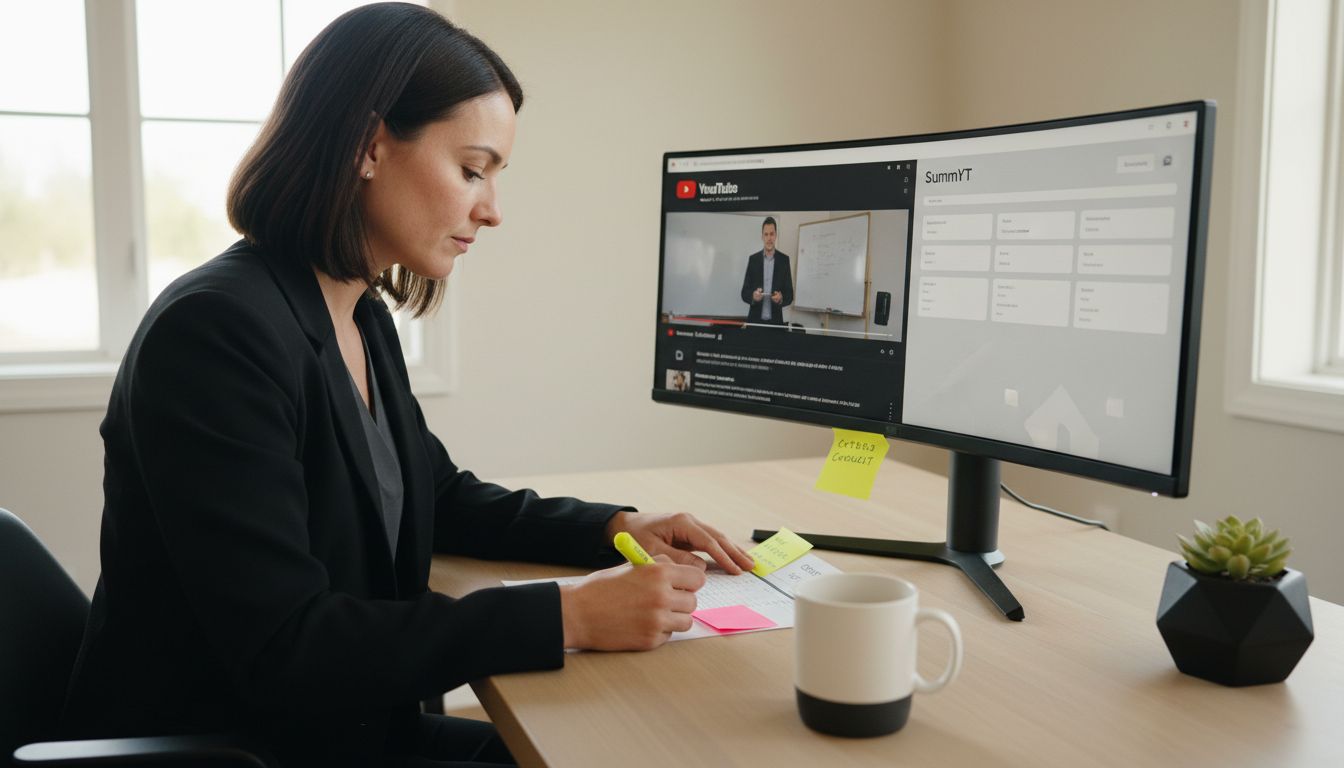Optimize Video Learning for Efficient Knowledge Gain

Over 90 percent of people forget most of what they watch online within a few days. Turning video watching into a powerful learning experience takes more than just clicking play. With so much content available, having a clear method to capture, organize, and actually use what you learn makes all the difference. This guide reveals proven steps that help you extract real knowledge from every video, so your screen time translates into lasting skills and insights.
Table of Contents
- Step 1: Define Clear Learning Objectives For Each Video
- Step 2: Select Optimal Videos And Access With SummYT
- Step 3: Generate AI-Powered Summaries To Capture Key Insights
- Step 4: Review And Organize Summarized Content For Fast Reference
- Step 5: Assess Comprehension And Apply New Knowledge
Quick Summary
| Key Point | Explanation |
|---|---|
| 1. Define clear learning objectives | Establish specific goals to enhance focus and retention while watching educational videos. |
| 2. Select optimal videos using criteria | Choose videos from credible sources and ensure they align with your learning objectives for effective learning. |
| 3. Generate AI-powered summaries | Use AI technology to extract key insights from videos quickly, making information more digestible. |
| 4. Review and organize summaries | Create a structured personal knowledge base by organizing summaries for easy access and reference. |
| 5. Assess comprehension and apply knowledge | Test your understanding and actively apply what you’ve learned to reinforce retention and practical application. |
Step 1: Define clear learning objectives for each video
Defining clear learning objectives transforms passive video watching into an active, purposeful learning experience. By setting specific goals before you start, you maximize your knowledge retention and focus your attention on what truly matters.
According to Carnegie Mellon University, effective learning objectives should clearly articulate what you intend to understand, learn, or be able to do after watching the video. Start by asking yourself: What specific knowledge or skill do I want to gain? For instance, if you are watching a technical tutorial, your objective might be “Understand the core programming syntax” or “Learn three specific debugging techniques.”
To create robust learning objectives, follow a simple three-step approach: First, identify the specific topic or skill you want to master. Second, determine the depth of understanding you seek (basic comprehension, detailed analysis, or practical application). Third, ensure your objective is measurable so you can assess whether you’ve successfully achieved it. An example might look like: “By the end of this video, I will be able to explain the five key steps of project management and provide a real-world example for each.”
Pro tip: Write down your learning objectives before starting the video. This simple act of intentionality will dramatically improve your focus and information retention. How to Optimize Video Learning for Faster Comprehension can provide additional strategies to enhance your learning approach.
Remember, the goal is not just to watch a video, but to extract meaningful knowledge that you can apply in your personal or professional context. By defining clear objectives, you transform video learning from a passive experience into an active, targeted knowledge acquisition strategy.
Step 2: Select optimal videos and access with SummYT
Selecting the right videos is a critical step in transforming your learning experience from random content consumption to strategic knowledge acquisition. In the vast ocean of online educational content, finding high-quality videos that align with your learning objectives can feel overwhelming.
When searching for optimal learning videos, consider several key criteria. Look for content created by subject matter experts, with clear presentation styles, and comprehensive coverage of your chosen topic. How to Optimize Video Learning for Faster Comprehension suggests prioritizing videos from reputable sources like academic institutions, professional trainers, or recognized industry experts. Pay attention to video length, production quality, and viewer engagement metrics.
With SummYT, accessing and extracting value from these videos becomes remarkably simple. The platform allows you to quickly import any YouTube video and generate concise, focused summaries that capture key insights. This means you can preview content, understand its core message, and decide whether it truly meets your learning objectives without watching the entire video. How to Summarize Videos Efficiently With AI Tools provides additional strategies for maximizing your video learning efficiency.
Pro tip: Diversify your video sources. Do not rely on a single channel or creator. Explore multiple perspectives and cross reference information to develop a more comprehensive understanding of your chosen subject. This approach will help you build a more nuanced and robust knowledge base.
Remember, the goal is not just to watch videos but to extract meaningful learning that you can apply in real world contexts. SummYT transforms this process by giving you powerful tools to filter, summarize, and internalize knowledge quickly and effectively.

Step 3: Generate AI-powered summaries to capture key insights
Generating AI-powered summaries transforms complex video content into digestible, actionable knowledge. This step is crucial for turning hours of video watching into precise, targeted learning experiences that save you time and maximize information retention.
Understanding the Advantages of AI Summaries reveals that AI technology can analyze video content with remarkable precision, extracting core concepts and key insights faster than manual note taking. With SummYT, the process is straightforward. Simply paste the YouTube video URL into the platform, and the AI will automatically generate a concise summary that captures the essential information.
To get the most out of AI-powered summaries, approach the process strategically. Start by importing videos that directly align with your predetermined learning objectives. The AI will break down complex topics into clear, structured points that highlight main ideas, critical arguments, and significant details. This approach allows you to quickly assess whether a video meets your learning needs without watching the entire content.
Pro tip: Use the generated summaries as a preliminary screening tool. If the summary resonates with your learning goals, watch the full video for deeper understanding. If not, move on to another resource. This method dramatically reduces time spent on irrelevant content and increases the efficiency of your learning process.
Remember, AI summaries are not replacements for comprehensive learning but powerful tools that help you navigate and prioritize educational content. By leveraging SummYT’s technology, you transform video learning from a passive, time consuming activity into an active, targeted knowledge acquisition strategy.
Step 4: Review and organize summarized content for fast reference
Reviewing and organizing AI-generated video summaries transforms passive information consumption into an active learning strategy. This critical step helps you create a personalized knowledge repository that you can easily access and reference whenever needed.
Benefits of Content Summarizers: Complete Guide highlights the importance of strategic content organization. When reviewing summaries, focus on extracting key concepts, main arguments, and actionable insights. SummYT provides tools that allow you to highlight, tag, and categorize summaries, making your learning process more structured and efficient.
Develop a consistent organizational system that works for your learning style. Consider creating folders or tags based on subjects, skill levels, or professional domains. This approach enables quick retrieval of specific information when you need it most. For instance, you might create categories like Professional Development, Technical Skills, Industry Trends, or Personal Growth.
Pro tip: Supplement your AI summaries with personal notes and reflections. While the AI captures core content, your unique perspective adds context and deeper understanding. Annotate summaries with questions, personal insights, or potential applications to transform passive summaries into active learning tools.
Remember, the goal is not just to collect information but to create a dynamic, searchable knowledge base that supports continuous learning and personal growth. By systematically reviewing and organizing your video summaries, you build an intelligent resource that evolves with your knowledge and interests.
Step 5: Assess comprehension and apply new knowledge
Assessing your comprehension and actively applying new knowledge transforms passive learning into a powerful personal development strategy. This crucial step ensures that the information you have absorbed becomes a functional part of your intellectual toolkit.
According to Carnegie Mellon University, effective learning assessment involves more than simple recall it requires demonstrating understanding through practical application. Start by creating personal challenges that test your grasp of the material. This might involve explaining the concept to someone else, writing a summary in your own words, or identifying real world scenarios where the new knowledge could be implemented.
Develop a systematic approach to knowledge application. Break down the key insights from your video summaries and design specific experiments or projects that allow you to put those insights into practice. For example, if you learned about a new marketing strategy, create a mini project where you design a hypothetical campaign using those principles. This hands on approach not only reinforces your learning but also helps you understand the practical nuances that theoretical explanations might not capture.
Pro tip: Embrace the learning cycle of reflection and iteration. After applying your new knowledge, take time to analyze what worked well and what could be improved. This metacognitive approach turns every learning experience into an opportunity for continuous improvement and deeper understanding.
Remember, true learning is not about memorization but about transformation. By actively assessing your comprehension and finding meaningful ways to apply new knowledge, you turn information into a dynamic tool for personal and professional growth.
Maximize Your Learning with SummYT’s AI-Powered Video Summaries
The challenge of turning endless YouTube videos into meaningful knowledge is real. You want to set clear learning objectives and find the best content, but spending hours watching is draining. The article highlights how defining goals, selecting quality videos, and reviewing content efficiently are key to mastering new skills without wasting time. If you feel overwhelmed by the sheer volume of material or struggle to capture core insights, SummYT is designed to solve exactly these pain points.

Take control of your video learning today with SummYT. Our AI creates clear, concise summaries from any YouTube video, helping you focus on what matters most without watching every second. Whether you are a student, professional, or lifelong learner, SummYT equips you to generate key insights, organize knowledge, and apply it faster than ever before.
INFOGRAPHIC:infographic_content] Start saving time and gaining efficient knowledge now by visiting [SummYT’s homepage and discover how easy video learning can be with AI-generated summaries. Don’t let valuable learning slip through the cracks. Try SummYT today and transform the way you learn from YouTube videos.
Frequently Asked Questions
How can I define clear learning objectives for my video learning?
Defining clear learning objectives involves identifying the specific knowledge or skills you want to gain from the video. Start by asking yourself what you aim to understand or apply, and create measurable objectives, such as aiming to explain a concept in your own words by the end of the video.
What criteria should I use to select optimal videos for learning?
To select optimal videos, look for content from subject matter experts that clearly presents information and covers the topic comprehensively. Prioritize videos that have good production quality, are appropriately timed for your schedule, and show high viewer engagement to ensure an effective learning experience.
How do AI-powered summaries help me maximize my video learning?
AI-powered summaries can distill lengthy video content into digestible insights, allowing you to quickly grasp core concepts. To leverage this, import videos that align with your learning objectives and review the generated summaries to quickly assess whether they meet your needs without watching the full video.
What is the best way to organize video summaries for efficient referencing?
To organize video summaries effectively, create a structured system based on subjects or skills. Use tags or folders for different areas of focus, making it easier to retrieve specific content quickly when needed, which can enhance your overall learning efficiency.
How can I assess my comprehension after watching educational videos?
Assess your comprehension by applying the knowledge gained from the videos through practical exercises or projects related to what you learned. For instance, summarize the video’s concepts in your own words or demonstrate your understanding by explaining it to someone else, which can solidify your learning.
What steps can I take to apply new knowledge from videos in real-life situations?
To apply new knowledge, design specific projects or challenges that use the principles you’ve learned. Break down key insights into actionable tasks, like creating a mini project around a new strategy or concept, to reinforce your understanding and put theory into practice.




